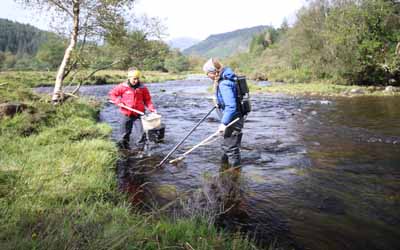Following applications submitted in 2023, Fisheries Management Scotland (FMS) was successful in receiving a combined £750,000 for four projects, covering Pink salmon eDNA surveillance & management, fisheries management planning and purchase of electrofishing equipment and seal deterrent equipment. The majority of this funding, or associated equipment, is for the benefit of FMS members. These awards are invaluable in helping our member network deliver projects and essential work in relation to fisheries management and assisting with delivery of national monitoring programmes. Further information on each project is below.
Pink salmon eDNA and management  project
project
This project supported a programme of eDNA sampling in late summer 2023 across a range of Scottish rivers to detect the presence of invasive, non-native Pink salmon and the costs of operating a fish trap on the River Thurso to capture these fish. This was a collaborative project involving FMS and members, the River Thurso Ltd, the Scottish Government Marine Directorate, NatureScot and the Scottish Environment Protection Agency. In summary, Pink salmon eDNA was consistently detected in 10 out of 32 studied rivers, demonstrating presence of these fish in these rivers. On a further five rivers, the presence of Pink salmon was suspected with various levels of confidence, inferred from the consistency of detecting eDNA in repeated water samples. Pink salmon eDNA was detected in rivers located on the east, west and north coasts of Scotland. The full findings of the programme will be published in due course and shared.
Fisheries Management Planning
This project aims to develop an online fisheries management plan template to be populated for all freshwater fisheries management units in Scotland. This will help deliver the objectives of the Scottish Government Wild Salmon Strategy. The approach we are using is an online “Storymap” developed by the Earth Systems Research Institute (ESRI). This will, for the first time, deliver a comprehensive and consistent approach to fisheries management planning across the whole of Scotland. These Storymaps allow for map-based data to be accessed in an interactive manner, and the plans will be accessible to a broad spectrum of end users, from the general public to government bodies, other NGOs and local management. This approach also allows all Management Actions for all districts across Scotland to be pooled into a single map layer, from which a dashboard can be used to examine Management Actions at a National level. This allows for common actions, themes, pressures and challenges to be identified both within and across Districts. The planning tool will allow ongoing analysis of management actions in the coming years, allowing government and local managers to assess progress against Scotland’s Wild Salmon Strategy and accompanying Implementation Plan.
 Purchase of electrofishing equipment
Purchase of electrofishing equipment
Electrofishing is an established method of conducting scientific surveys of juvenile fish, which allows for the identification of what species are present at a particular site in a river, and to produce an estimate of the abundance of those species. Electrofishing is used to assess the status of fish populations and identify where there are problems that may require management intervention. Electrofishing is conducted with a battery powered backpack, or in some instances a portable generator. A current is passed through the water which momentarily stuns fish and allows for their capture. Once a site has been surveyed, fish details can be recorded to identify species, life-stage and abundance. Genetic samples can also be taken for analysis and then fish are returned to the water unharmed. This sampling methodology is commonly used to monitor changes in fish abundance and has been used in the Scottish Government National Electrofishing Programme for Scotland (NEPS) and the National Introgression Programme for Scotland (NIPS), led by the Marine Directorate. The fund has been used to purchase electrofishing gear on behalf of FMS members delivering the NEPS and NIPS projects in the future, and to undertake local, routine fish monitoring programmes. The funding award has allowed the purchase of new electrofishing backpacks and control boxes, ancillary equipment such as lightweight lithium batteries and ergonomic anodes to reduce strain for users, fish welfare equipment (portable air pumps), and electrical conductivity meters to ensure that the correct voltage when electrofishing.
Purchase of seal deterrent equipment
This project will support efforts by salmon fisheries managers to protect salmon from seal predation by continuing to investigate, develop and test non-lethal methods of control, thereby improving our understanding of the effectiveness of these measures. Predation on wild Atlantic salmon by seals, particularly when small numbers of ‘specialist’ seals enter rivers to feed, is a concern in a number of rivers across Scotland. Research by Sea Mammal Research Unit (SMRU) has demonstrated that only a small proportion of seals develop this behaviour, and therefore a small proportion of seals can have a disproportionate impact on Atlantic salmon within Scottish rivers. Scottish Government and fisheries managers are focussed on non-lethal methods of preventing impacts from seal predation. SMRU is working with a number of Fisheries Management Scotland members to test the efficacy of Acoustic Deterrent Devices (ADDs) in preventing seals from entering rivers under real world situations. In particular, the use of mobile ADDs, mounted on suitable watercraft, have a particularly important role in deterring seals within rivers. Importantly, the use of ADDs within rivers will ensure that interactions with cetaceans, which are particularly sensitive to this technology, will be eliminated. The project will reduce predation pressure on wild salmon and sea trout, by increasing the capacity for river managers to deter seals from entering Scottish rivers. The project supports the purchase of Sealfence Portable acoustic systems, appropriate watercraft for deployment and bespoke CCTV to monitor the entry of seals into freshwater.
Fisheries Management Scotland is grateful to the Marine Fund Scotland for providing funding support to enable delivery of these projects.
